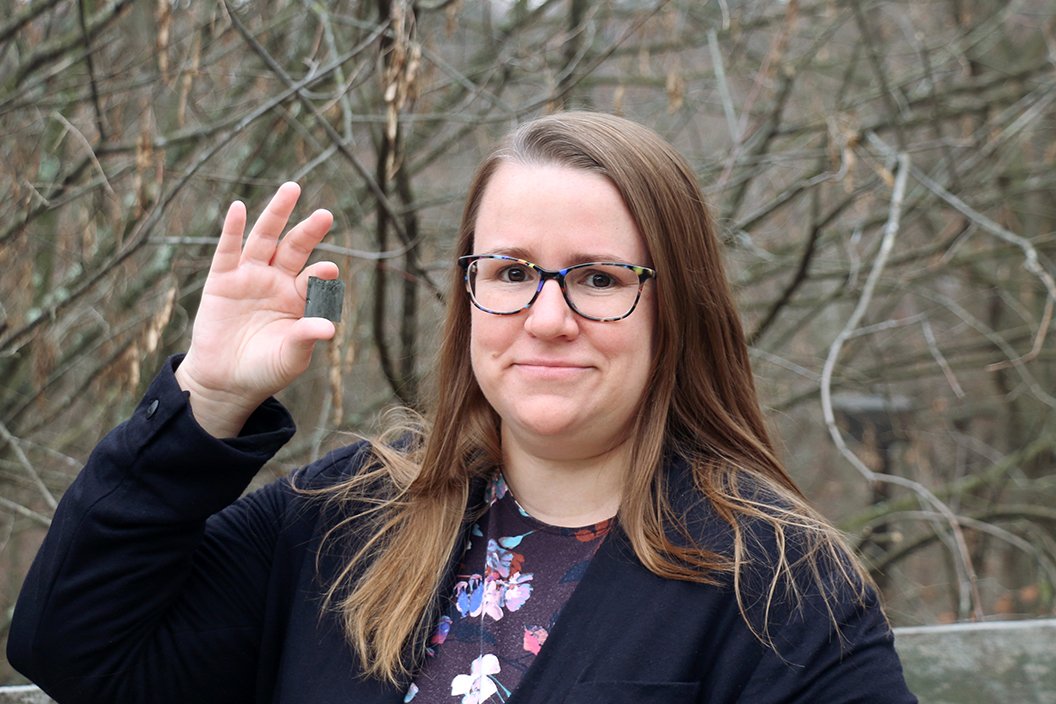Physicist Hillary Smith Receives Early Career Award from Department of Energy

Smith holds a piece of metallic glass that she is investigating in her lab at Swarthmore. Metallic glass has the same characteristics of high strength and a disordered structure that are shared by other glasses, but is composed entirely of metal atoms.
Assistant Professor of Physics & Astronomy Hillary Smith recently received an Early Career Award from the U.S. Department of Energy (DOE) for her proposal, “Vibrational Dynamics and Relaxations in Glass-Forming Liquids.” This award, granted by the DOE’s Office of Basic Energy Sciences, acknowledges emerging STEM leaders and bolsters the nation’s scientific workforce by supporting outstanding scientists at the outset of their careers, when many scientists do their most formative work. Smith is the first Swarthmore faculty member to receive this award.
While glass is ubiquitous in our lives, much is still unknown about what happens on the atomic scale when a molten liquid cools to form a glass, says Smith. Even while in a solid form, glasses are highly disordered on the atomic scale and look more like liquids. Smith’s award of $875,000 will support five years of her lab’s groundbreaking research, exploring a central question in condensed matter physics: How does glass transition from molten liquid to a solid glass?
Smith received a B.A. in physics and chemistry from Bryn Mawr College and a Ph.D. in materials science from California Institute of Technology. She joined Swarthmore's Department of Physics & Astronomy in 2018. Prior, Smith held positions as a visiting lecturer at Pomona College, senior scientist at Liox Power, postdoctoral researcher at Caltech, and visiting scientist at the Australian Nuclear Science and Technology Organisation.
Smith’s work will impact technological applications of glasses, providing unprecedented insight into the dynamics of a range of glass-forming liquids. These technological applications rely on our understanding of glass characteristics, including glass-forming ability, stability against crystallization, and bulk mechanical properties.
The Early Career Award enables crucial aspects of Smith's work, which begins with preparing and characterizing glasses in her lab at Swarthmore.
Smith and her students will prepare glasses and then perform measurements to determine their properties, like how they respond to changes in temperature. These investigations are challenging and require new experimental tools because the glasses are not stable when they are cooling to form a solid.
After the Swarthmore lab work, Smith, students, and the glasses will travel to Oak Ridge National Lab (ORNL) to perform measurements on instruments at the Spallation Neutron Source (SNS), which is the world’s brightest neutron source. The SNS has unique capabilities that will allow Smith to use cutting-edge techniques to capture what’s happening in the brief time window in which glasses are in a unique, metastable state.
Smith has already had the chance to take five students to ORNL for data collection in the last few years. The funding will support two students to work in Smith’s lab on campus each summer, visit ORNL for data collection, and present their work at national conferences. Smith will also hire a postdoctoral researcher to assist her and her students.
“I’m looking forward to the chance to introduce students to the exciting field of glass physics, travel with them to ORNL, and introduce them to the wide diversity of science that is investigated with neutron scattering,” says Smith.


